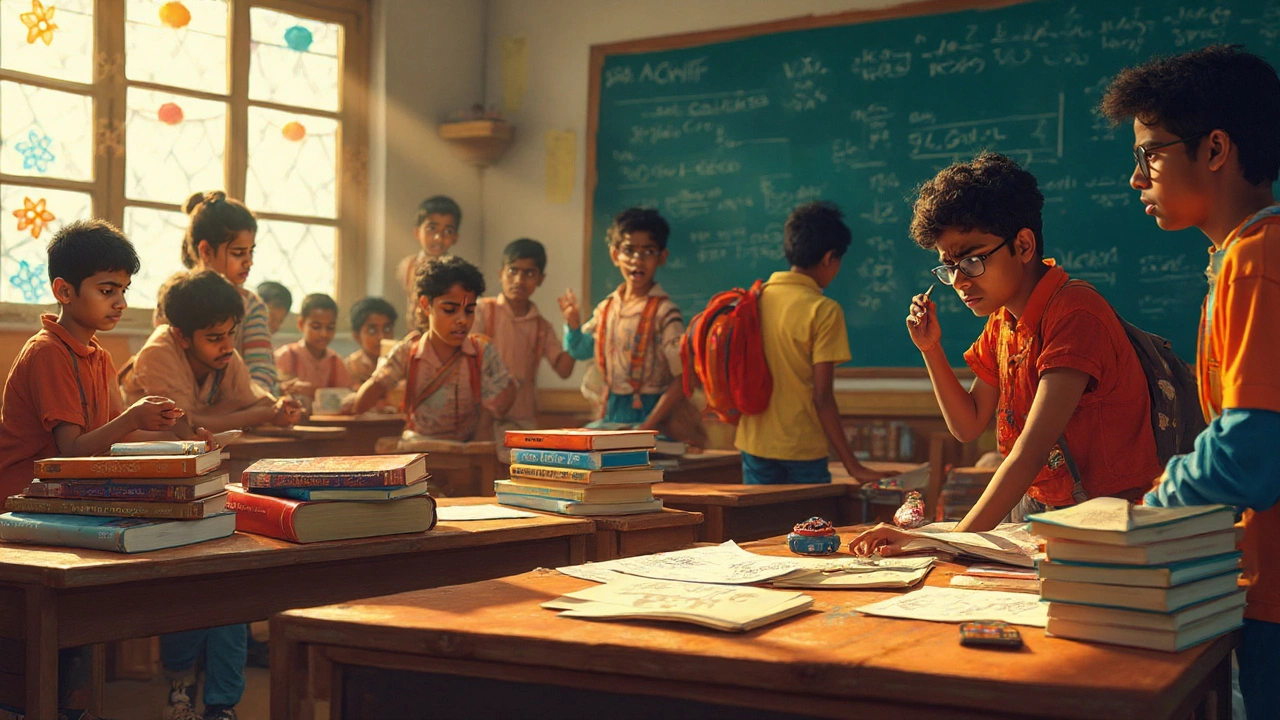"There’s no such thing as the 'easiest' JEE Advanced." If you’ve been around any IIT aspirant or alumni group, you’ve probably heard this whenever someone brings up the level of difficulty for the exam. But people can recall certain years and just grimace. So, which was the toughest JEE Advanced paper in history? Ask that in any coaching centre in Kota, and the debate will run well past midnight. Google trends spike every May and June, and the anxiety is real—students and parents want to know if that year’s paper outdid the legendary tough years or gave some relief instead. One thing’s for sure: JEE Advanced doesn’t get its mythical reputation for nothing. We’re diving deep into infamous years, eye-opening stats, and what actually makes a JEE Advanced paper so tough that students remember it for decades.
Legendary Tough Years: Which JEE Advanced Paper Sent Shivers Down Spines?
Every year, fresh exam-takers whisper among themselves, “Hope this year’s not a repeat of 2016…” or they’ll mutter darkly about getting “2018-level questions.” But which years really deserve that legendary status? Let’s get into specifics, actual question types, and firsthand battle stories from those who survived.
toughest JEE Advanced paper—if you search this phrase, you’ll see 2016 pop up a lot. That year, the Mathematics section for Paper 2 was brutal. Here’s a wild stat: the average mark in that section was barely 13 out of a possible 60. A Quantum Mechanics passage-based question took 15 minutes for most advanced coaching faculty—they later admitted it openly on Quora and in talks. Students floundered especially in Integration and Algebra. Social media that afternoon exploded with memes of the epic struggle.
2015 also deserves a mention for its fiendish Physics. The “rotation-heavy” questions in Paper 1, disguised as basic but loaded with concepts, tripped everyone except the top 1%. Out of about 1.25 lakh candidates, over 10,000 reported getting negative marks in at least one section—yes, negative, thanks to the dreaded marking scheme.
But if you want to see the biggest historical spike in cutoffs dropping, 2018 is a must-see. That year, the new online format brought its own glitches— multiple students saw screens freeze or questions suddenly switch, adding pure psychological terror to already difficult problems. The top scorer (Rank 1, Pranav Goyal) had 337 out of 360 in 2018, but fewer than 15 students broke the 300-mark barrier. Paper 2 Chemistry stands out for its confusing integer-type questions; even many mentors admitted they gave up after 20 minutes.
Going further back, the 2010 and 2012 IIT-JEE (before the renamed “Advanced”), were both regarded as monstrous. The 2012 paper had so many assertion-reason and matrix-match style questions that even those who practiced every coaching booklet couldn’t complete full sections. The thing is, every few years the exam body throws in an experimental pattern—like 2017, which brought more multi-corrects and made guessing riskier (and infamously frustrating).
| Year | Average Score (Top 10) | Lowest Cutoff | Question Type Standout |
|---|---|---|---|
| 2010 | 285/480 | 190 | Matrix-Match, Integration |
| 2012 | 293/401 | 209 | Assertion-Reason, Organic Chemistry |
| 2015 | 342/504 | 105 | Rotation in Physics |
| 2016 | 320/372 | 75 | Mathematics Integration, Probability |
| 2017 | 339/366 | 90 | Multi-correct answers |
| 2018 | 337/360 | 126 | Online Platform Issues, Chemistry Integer Type |
So was it 2016, 2018, or one of the old-school papers? For most teachers and toppers, 2016 takes top honors for sheer problem-solving brutality, but 2018 wins for demoralizing everyone with its new online chaos. Pick your poison: time-consuming calculations, impossible-to-eliminate options, or glitches that made you fantasize about running away and becoming a zookeeper instead.

What Actually Makes a JEE Advanced Paper So Tough?
If you’re not in the JEE world, it’s hard to get why some papers are called “legendary tough.” It’s not just the chapters or supersized syllabi—it’s more about how the paper sets clever traps and tests grit, not just memory. Let’s break down the actual features that turn a JEE Advanced paper from hard to hair-pulling.
The biggest pain point is the mix of conceptual depth and trick questions. For example, a classic 2016 integration question actually hid a coordinate geometry twist, which meant if you didn’t spot it fast, you spent 15 minutes slogging through useless steps. Multi-correct questions? If you’re not sure about option C, but you select A and B, you don’t get partial credit. Worse, sometimes you get negative marks for partially correct answers. You can be 90% right and still walk out with less than zero.
Most years, about 90,000-1,50,000 students appear for Advanced. On paper, “only” the top 2 lakh from JEE Main get to sit for it, but the competition feels ferocious. The paper setters are experts (often from IITs themselves), and they intentionally set questions that combine 2-3 chapters. You’ll see something that looks like a basic Electrostatics problem, but halfway in, realize you need Calculus to finish it. Time crunch is real: the entire paper, two sessions, each with 54 questions (mix of single correct, multiple correct, integer, and match-the-columns), with barely enough reading time.
Sectional difficulty spikes can break morale completely. Those years with 5+ challenging math integrals or strange organic chemistry mechanisms make everyone question their preparation. There’s also exam fatigue. Even if you nail Physics, Chemistry can sucker-punch you in the second half.
Marking schemes matter too. For example, in 2017, partial marking was introduced in some multiple-correct questions for the first time. Sounds nice, right? Except the trap is you have to be hyper-precise; one extra tick and out goes your credit. There’s also psychological warfare: one question will look impossibly easy, making you second-guess yourself and lose time in doubt.
- Experimentation: Every few years, examiners change formats: match-the-following, assertion-reason, or introducing new question types online. Students’ routines get shaken up.
- Surprise Weightage: Sometimes “small” chapters (like Environmental Chemistry or Probability) suddenly carry weight, and if you skipped them, you’ll regret it big time.
- Ambiguous Wording: Some questions in the 2012 and 2016 papers were worded vaguely, leading to different interpretations and massive debate even among teachers.
- Huge calculations: Problems with long, multi-step solutions that drain not just time but also your will to live if you get a silly calculation wrong at Step 7 of 10.
- New online format: 2018 brought digital nerves—lag, login errors, and a totally different strategy needed for screen-based tests instead of paper.
In short, a "toughest JEE Advanced paper" is one that combines surprise factor, brutal time management, never-seen question styles, and marking schemes that reward only the eagle-eyed. It's the perfect storm you can't always practice for, which is what separates it from other exams.

Tips For Future Aspirants: Learn From The Toughest Papers
Anyone aiming for an IIT seat is probably already buried under books, but there's no way around the fact that paper disasters do repeat—and learnings from tough years can set you apart. Here are some real lessons (not just the "study more" advice) from students and teachers who've stared down those legendary exams and lived to tell the tale.
- Simulate chaos, not comfort. Don’t just practice with sanitized, perfectly printed question booklets at home. Try mock tests with time pressure, with distractions, with friends shouting answers nearby, or while sitting on an uncomfortable stool. The tougher the environment, the more resilient you’ll be when the actual paper throws curveballs.
- Mindset trumps memory. In years like 2016 and 2018, the best students weren’t the ones who had memorized every equation—but those who didn’t crumble when staring at something unfamiliar. Spend time on mental stamina—quick breaks, deep breaths, and positive self-talk work wonders mid-exam.
- Don’t skip the “easy” chapters. Every so-called side topic (like Atomics, Environmental Chemistry, or Probability) comes up big in legendary tough years. Many toppers have won rank jumps by quickly nailing these when everyone else floundered.
- Precision matters with new formats. If you see rumors about partial marking or online changes, practice on those very formats—not just last year’s papers. The best coaching centers now simulate online exams with glitches, so you aren't shocked if your system lags or a question’s numbering is off.
- Pace, don’t panic. Deadlines are tight, but panicking over one question ruins a whole section. Track time relentlessly; if a question sucks you in for more than 4 minutes, mark and skip.
- Follow the official answer keys—and discuss errors. Each year, some questions are challenged and canceled. Going over previous years’ errata will make you good at spotting ambiguous language, saving time and boosting confidence if something seems “off.”
- Reverse-engineer toppers’ strategies. Notice how 2016 AIR-1 Aman Bansal split time between sections, or how 2018’s Pranav Goyal took pauses to re-center after tough questions. Many toppers recommend starting with your strongest subject for a quick morale boost.
Here’s a stat for motivation: despite the horror stories, less than 2% actually crack JEE Advanced. But history says there’s no telling which paper will suddenly get “legendary” status next, so flexibility wins over raw grind. Look up past year experiences on old Quora threads or YouTube—real exam-takers spill the gutsy details, from crying in the toilet to literally shouting for joy post-exam. Those who adapt, stay calm, and keep their heads usually manage to at least survive, if not shine.
JEE Advanced has always had a reputation for unpredictability. If you’re gearing up, remember: sometimes it’s not about “beating the toughest paper ever”—it’s about not letting the paper beat you. And who knows, maybe your year sees the next legendary spike in difficulty—and you become the survivor everyone admires for years to come.
